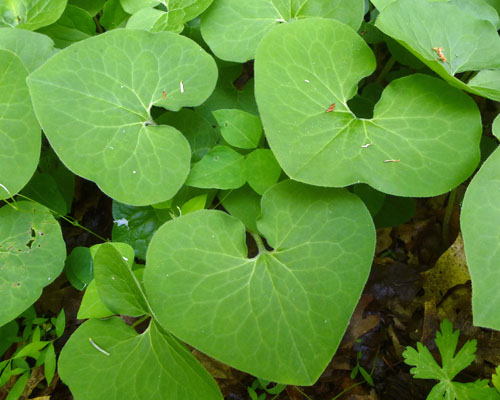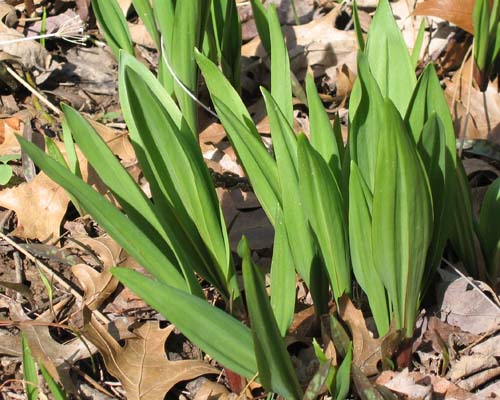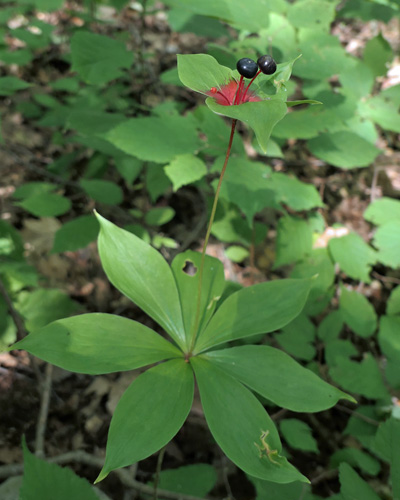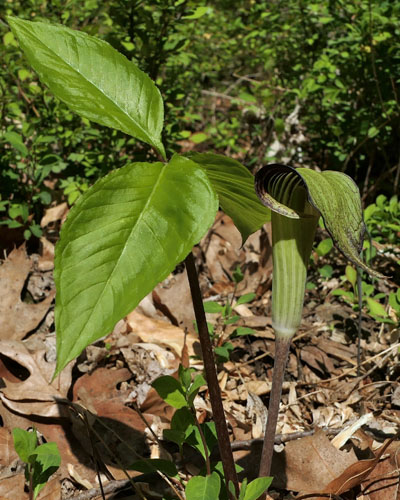Home Resources Gardener News reprints: Please Don’t Eat The Wild Turnip!
This article by Hubert Ling (NPSNJ horticulture) was published in Gardener's News without the photos. He is a regular contributing writer to Gardener's News. Photos by H & M Ling.
Please Don’t Eat The Wild Turnip!
While you are at it please don’t eat the wild ginger, wild leeks, Indian cucumber, or other native plants either. You might ask why. The best simple answer is that they aren’t very good or even awful and dangerous. In addition, it is immoral and monetarily indefensible. The reasons why are fairly obvious. Cultivated crops are almost exclusively large, sun loving, plants which have had their chemical defense arsenal drastically reduced by careful breeding; thus they grow fast and taste good. However, since most of the Eastern US was originally covered in forest, almost all the understory native plants are shade-loving, slow growing, and full of toxins to prevent herbivory. Sunny areas for herbaceous plants are limited to extreme habitats such as animal trails, river flood zones, mountain balds, avalanche zones, areas with frequent fires, and swamps. These areas are relatively rare and thus most of our tenacious, native, herbaceous plants are relegated to the shade where growth is perhaps 1/25 that of sunny areas.

Just about the only time it is justifiable to consume a native plant is if you have grown it yourself and are just eating a little of the excess. So after 25 years of growing wild ginger I tried some. Big mistake!! Well it was awful, had a very strong unpalatable flavor, and seemed poisonous which I found out later was the truth. Wild ginger can cause kidney failure and should be avoided. Commercial ginger can produce about a pound of ginger per square foot per year. You may get about 1/45 of a pound with wild ginger. Commercial ginger gives you a pleasant, aromatic, safe product which out produces the wild counterpart 45/1 and you don’t have to visit your urologist.

How about wild leeks? The commercial leek weighs about 1/2 lb. takes up about 16 square inches of soil, and 1 year to grow to maturity. A wild leek takes up about 2 square inches of soil so you can grow about 8 wild leeks in the space of one commercial leek. However, a wild leek weighs about 0.17 oz. and takes 5 years to mature. The ratio is about 200/1 in favor of the commercial leek.

'PLEASE DON'T KILL ME'!
Even worse is the contest between the native Indian cucumber and Burpee Burpless. With 1 or 2 commercial cucumber plants in 1 square yard, you might expect about 25 cucumbers a year or about 12,500 cubic cm of cucumber. Cucumber plants are very easy to grow. However, Indian cucumber will only grow in the shade and probably needs a special fungal mycorrhizal partner. In other words if you try to grow it, it probably won’t. Indian cucumber plants are small so 144 of them could grow in 1 square yard. I have never seen them that dense but we can just suppose. The ‘cucumber’ rhizomes are about 1.8 cubic cm and take about 10 years to grow. The ratio is at least 500/1 in favor of the commercial cucumber although a more realistic figure might be 5,000/1 if only 15 Indian cucumbers will grow naturally in 1 square yard.

Finally we have the wild turnip. Jack-in-the-pulpit has been called wild turnip since the corm from ‘Jack’ can grow to about 3” in diameter in perhaps 40 years and it is about the size and shape of a turnip. I have only seen 1 Jack which had leaves about 1 yard long and probably a 3” ‘turnip’ although I have seen a few Jacks about 2’ x 2’ high and many about 1.5’. A commercial 3” turnip is ready in one year and about 40 turnips will fit in in 1 square yard. Thus we have a ratio of about 800/1 in favor of the commercial turnip of course. Commercial turnips are ready to process immediately while the Jack’s corm must be sliced thin and hung for 1 year to allow toxic concentrations of oxalic acid to dissipate.
Do yourself a favor and stick to commercial fruits and vegetables. Your taste buds and general health will benefit from that decision. Most native plants are not that common and foraging can easily eliminate populations forever.